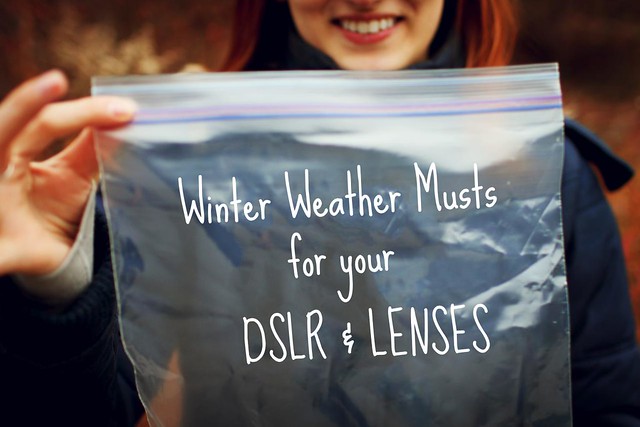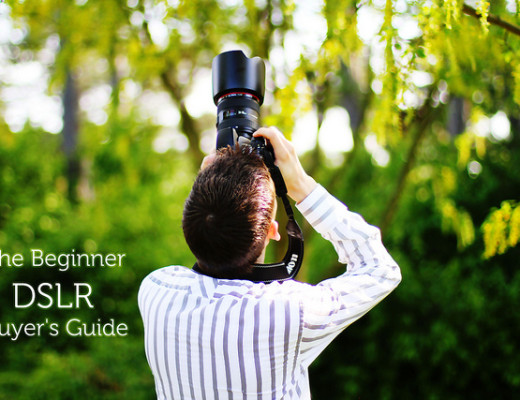


This post is a bit wordy. If you want to skip the explanation, just read the stuff under the big bold headers.
The colder the air the lower the moisture content. That means when you take your camera inside after being outside in the cold for a while, condensation can form on the insides of your camera. As you may remember from childhood (either: Hairdryer in bath = NO, or: Spilled water on iPod = PANIC MODE) water on electronics is never good!
When you make your way outside, keep your camera zipped up inside your coat or in your camera bag for as long as possible. If it’s really cold outside it’s best to leave it out once you’ve taken it out. I know it’s tempting to stuff it back in your coat, but depending on how warm you are and how cold it outside, that could be a really bad mistake. Remember, we don’t want any condensation inside the camera. So if it’s really cold and you’re layered up and extremely warm, chances are when you stick the camera back in your coat it will be too fast of a transition.
Before you throw your hands up and retire your camera for the season, hear me out. You can protect it from the outside and the inside and still have a great time shooting. All you need is a Ziploc bag.
WINTER WEATHER PROTECTION GEAR
- A large plastic seal-able (Ziploc) bag that fits over your camera and lens.
- A small microfiber cloth for wiping down your lens when the inevitable snowflake hits.
- OPTIONAL: A second large plastic seal-able (Ziploc) bag that fits over your camera and lens, with a hole cut out that just fits over the tip of your lens. This is if your camera is not professionally weather sealed (check your manual or Google your model to find out) or if you just want that extra bit of protection from snow or the camera getting wet. If you feel like you might be too embarrassed shooting with your camera stuffed in a Ziploc bag, there are ready-made waterproof bags that do the trick for rain, snow, or light underwater activity. Honestly though, you can make the same thing yourself with a $10 ultraviolet filter and a plastic bag. You can also wrap up the important bits in cling wrap. The choice is yours!
Okay, if there isn’t snow on the ground and it isn’t raining, you’ll only need the one Ziploc bag. Before you head inside to your home, a grocery store, or even a warm car, put your camera inside the bag and seal it shut. Once you’re inside, leave the camera in the bag until it’s around room temperature. I know, I know, you want to look at your photos immediately when you arrive inside, but you must leave the camera in the bag sealed. If you really can’t wait, take the memory card out before you head inside.
NOTE: If you’re like me and like to go to indoor tropical gardens or butterfly conservatories in the winter, or even if you live in tropical conditions, remember the same thing applies! It may look silly to be carrying your camera in a Ziplock bag for ten to fifteen minutes before you start snapping but it’s important. Remember, it’s going from cold to hot that you need to worry about condensation. Air conditioning to an 80°F humid conservatory counts!
That’s it. Now go out, shoot like crazy, and have fun knowing your gear will last you years to come.
VENTURING OUT
- Cold air = low moisture content
- Once the camera is cold, leave it cold.
- Batteries die faster. Carry spares if you’ll be out long.
LET IT SNOW
- Use your microfiber cloth to wipe away snow or water droplets.
- If it’s a big snowstorm, use a second Ziplock bag with a hole over the lens. You can tape it in place.
HEADING INSIDE
- Put your entire camera and lens inside your Ziplock bag before going inside.
- Camera should be room temperature before removing.






12 Comments
Nadine Jaisler
17 Feb 2017 at 10:24 amI know this may sound silly, but I want to be clear, your saying shoot with the plastic bag on with a UV filer in snow weather?
Sara
2 Apr 2017 at 11:57 pmNo, you don’t shoot with the plastic bag on it. You shoot like your normally would, but before you come inside for the day into the warm house, you put the camera inside the plastic bag so it can acclimate without damaging your gear. 🙂
Jovi
29 Dec 2012 at 12:36 amThanks for this post! I never realized that cold air would cause problems for my camera. Yesterday I was walking around the city at around 37degrees and my camera was freezing and at that time I was not really concerned that it would harm my camera. Do you think that this one time ordeal could harm my camera?
Sara
30 Dec 2012 at 4:45 pmHi Jovi,
You should be fine. Honestly a lot of people go without ever taking that extra precaution but it does help prolong the life of your camera. Next time just slip a ziplock bag into your purse. =)
(I hope you had fun walking around with your camera.)
Rachael
2 Dec 2011 at 2:36 pmI saw your website linked on the happy honey and lark blog – and i’m loving the tips. Although I don’t have a DSLR [just a bridge camera] atm its really useful to know these tips especially because we’re going to Chicago next week and I can imagine it being rather chilly and cold. Simple tips yet totally practical!
shellymc
25 Nov 2011 at 5:55 pmWhat a great tip! Just found your blog Sarah, and I looooooove your photography, especially your snaps of Dun Laoghaire and Blackrock — I live in Dun Laoghaire myself, it was such a pleasant surprise to see my hometown pictured here!
Sarah
25 Nov 2011 at 3:25 amI did this today! We are staying in Government Camp, Oregon for the holiday and it is snowing like crazy outside. I got some wonderful shots but didn’t have to stress too much about the camera thanks to you!! : )
christina
23 Nov 2011 at 5:17 pmHa. Brilliant. I live in Montana where it’s extra cold and extra dry outside, and I worry about condensation yet want to take photos outdoors… THANK YOU for this tip!
Jesue V
23 Nov 2011 at 10:45 amHi, thank you for this post. I didn’t even think about condensation until I read this.
I find your photographs very inspiring by the way. Care to comment on my own pictures on my blog?
Kim
21 Nov 2011 at 11:10 pmGreat post, Sara! As far as keeping your camera dry, they make these great things for non-weatherproofed dslrs I like to call “camera condoms” because I can never remember what they’re actually called. i’ll tweet you a link when I hop back onto the laptop. 🙂
Lauren
21 Nov 2011 at 4:16 pmI can attest to the importance of this trick when I suffered a fractured motherboard last winter when it was below zero out. I took my camera to a local repair shop and he had to send it to nikon. A trick I learned is very similar and probably less handy, but if you are at home just as easy: use an insulted lunch bag that you pop the camera in and out of while you wait for tempature adjustments. It was an interesting experience all around, but I’ll probably try your trick because the zip loc is small and can mash into a pocket when you’re not using it. Thanks for sharing! 🙂
Sarah
21 Nov 2011 at 3:59 pmOr better yet see if your camera works with a wireless EyeFi card that will upload your pictures without ever having to remove your memory card : ) That is my camera must have, love, love!!
Thanks for the weather tips!!